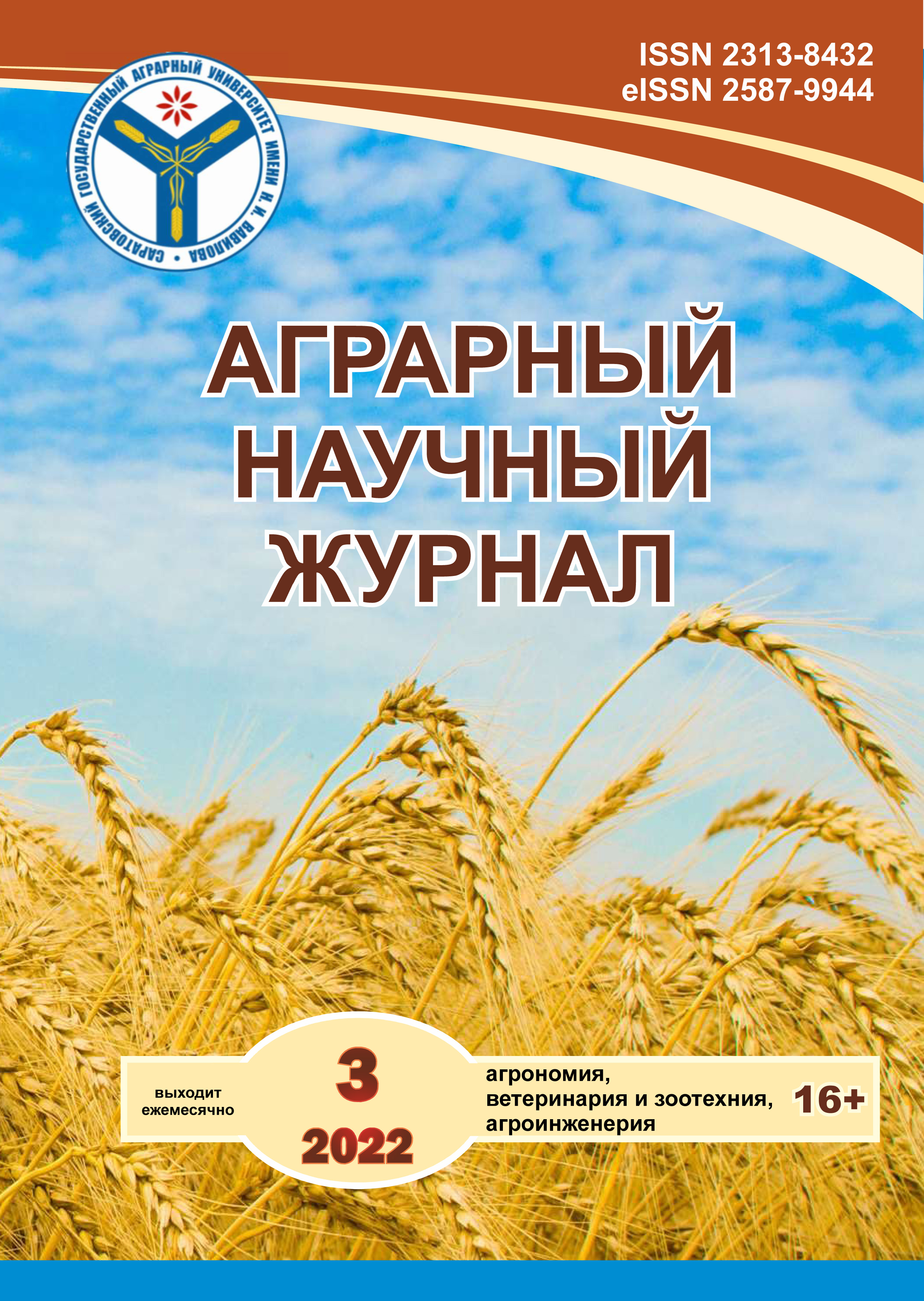The biochemical composition of gwizotia (Guizotia abissinica) oil seeds depending on growing conditions
DOI:
https://doi.org/10.28983/asj.y2022i3pp23-26Keywords:
Guizotia abyssinica, cultivation region, productivity, oil content, fatty acid compositionAbstract
This paper presents a comparative assessment of the content of fatty acids in the oil seeds of Abyssinian Guizotia grown in various agro-climatic regions. The Guizotia seeds grown in contrasting agro-climatic regions had a high and stable yield of 1.38-1.75 t/ha. The fat content in Guizotia seeds varied within 36.51-40.18%. On the rich chernozem soils of the Penza and Tambov regions, the fat content is 39.21 and 38.74%, respectively. A low amount of fat was noted on slightly humus soils of the Volgograd and Astrakhan regions (36.51 and 36.73%). The main component of the fatty acid composition of Abyssinian Guizotia oil is a polyunsaturated fatty acid - linoleic, the content of which reaches a high value from 65.85 to 80.01%. Its maximum content reaches in seeds from Penza and Tambov (79.17 and 80.01%). At higher temperatures and poor soils in North Ossetia-Alania, a decrease in the concentration of this acid to 65.85% was noted. At the same time, the concentration of oleic and palmitic acids increases here to 9.16% and 9.17%, the values of which are 1.2-1.7 and 1.1-1.3 times higher than these figures in other areas. The content of saturated stearic acid ranged from 4.91% (Tambov) to 8.90% (Astrakhan). The concentration of linolenic acid remains at a low level of 0.14-0.39%, with its maximum value in the original seeds grown in the homeland (Ethiopia). The percentage of arachidic acid is 0.12-0.70%, with its maximum in oil seeds grown in the Astrakhan region. Hotter, drier conditions during the growing season of Guizotia tend to increase saturated acids and decrease linoleic acid.
Downloads
References
Айтбаева Г.К. Народно-хозяйственное значение растений Crotalaria Alata и Guizotia Abyssinica // Теория и практика современной науки. 2017. № 6 (24). С. 33-36.
Буянкин В.И., Прахова Т.Я, Бекузарова С.А. Испытание масличной культуры гвизоции (Guizotia abissinica Cass) // Кормопроизводство. 2017. №10. С.26-28.
Доспехов Б.А. Методика полевого опыта М.: Агропромиздат, 1985. 207 с.
Зеленков В.Н., Карпачев В.В., Белоножкина Т.Г., Воропаева Н.Л., Лапин А.А. Жирнокислотный состав семян нуга абиссинского, их суммарная антиоксидантная активность и перспективы практического использования Российского сорта «Липчанин» // Новые и нетрадиционные растения и перспективы их использования. 2017. № S 12. С. 12-14.
Исакова А.Л. Гвизоция абиссинская – нетрадиционная масличная культура // Наше сельское хозяйство. 2021. № 21 (269). С. 60-63.
Прахова Т.Я., Прахов В.А. Интродукция культуры Guizotia abissinica Cass в условиях Средневолжского региона // Таврический вестник аграрной науки. 2018. №2 (14). С.96-102.
Турина Е.Л., Ефименко С.Г., Прахова Т.Я., Паштецкий В.С., Радченко Л.А. Урожайность семян и качество масла GUIZOTIA ABYSSINICA в условиях Центральной степи Крыма // Таврический вестник аграрной науки. 2021. № 1 (25). С. 205-212.
Bhavsar G.J., Syed H.M., Andhale R.R. Characterization and quality assessment of mechanically and solvent extracted Niger (Guizotia abyssinica) Seed oil // Journal of Pharmacognosy and Phytochemistry. 2017. № 6 (2). P. 17-21.
Cruz-Cruz C.A., Gonz?lez-Arnao M.T., Engelmann F. Biotechnology and conservation of plant biodiversity. Review // Resources. 2013. Vol. 2. P. 73-95.
Deme T., Haki G. D., Retta N., Woldegiorgis A., Geleta M. Mineral and anti-nutritional contents of niger seed (Guizotia abyssinica (L.f.) Cass.), linseed (Linum usitatissimum L.) and sesame (Sesamum indicum L.) varieties grown in Ethiopia // Foods. 2017. Vol. 6 (4). Р. 27.
Geleta M., Ortiz R. The importance of Guizotia abyssinica (niger) for sustainable food security in Ethiopia // Генетические ресурсы и эволюция сельскохозяйственных культур. 2013. № 60. P. 1763-1770.
May W.E., Wood M.D., Piero K.D. Niger response to nitrogen and seeding depth in the Northern Great Plains // Agronomy Journal. 2019. Vol. 111. Iss. 2. P. 741–748.
Mengistu B., Gebrselassie W., Disasa T. Diversity Analysis in Guizotia abyssinica (L. f.) Cass. Germplasms Collected from Ethiopia // Chemical and Biomolecular Engineering. 2020. Vol. 5. No. 1. P. 8-14.
Ranganatha A.R.G., Panday A.K., Bisen R., Jain S., Sharma S. Niger breeding oilseed crops for sustainable production // Opportunities and Constraints. 2016. No. 1. Р. 169-199.
Zekiros F. The сontribution of managed honey bees to crop pollination, food security, and economic stability: case of Ethiopia // The Open Agriculture Journal. 2019. Vol. 13. P. 175–181.
Downloads
Published
Issue
Section
License
Copyright (c) 2022 The Agrarian Scientific Journal

This work is licensed under a Creative Commons Attribution-NonCommercial 4.0 International License.








